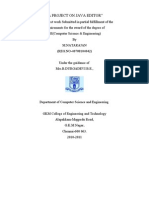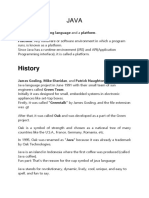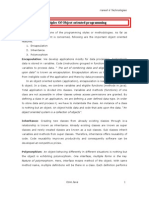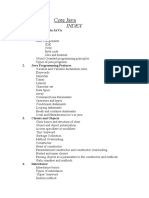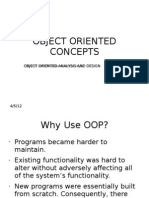History of The Java™ Programming Language
Uploaded by
syedazharuddinHistory of The Java™ Programming Language
Uploaded by
syedazharuddinJava Programming/History
Java Programming/History
On 23 May 1995, John Gage, the director of the Science Office of the Sun Microsystems along with Marc Andreesen, co-founder and executive vice president at Netscape announced to an audience of SunWorldTM that Java technology wasn't a myth and that it was a reality and that it was going to be incorporated into Netscape Navigator.[1] At the time the total number of people working on Java was less than 30.[1] This team would shape the future in the next decade and no one had any idea as to what was in store. From being the mind of an unmanned vehicle on Mars to the operating environment on most of the consumer electronics, e.g. cable set-top boxes, VCRs, toasters and also for personal digital assistants (PDAs).[2] Java has come a long way from its inception. Let's see how it all began.
The Green team
Behind closed doors, a project was initiated in December of 1990, whose aim was to create a programming tool that could render obsolete the C and C++ programming languages. Engineer Patrick Naughton had become extremely frustrated with the state of Sun's C++ and C APIs (application programming interfaces) and tools. While he was considering to move towards NeXT, he was offered a chance to work on new technology and the "Stealth Project" was started, a secret nobody but he knew. This Stealth Project was later named the "Green Project" when James Gosling and Mike Sheridan joined Patrick.[1] Over the period of time that the Green Project teethed, the prospects of the project started becoming clearer to the engineers working on it. No longer was its aim to create a new language far superior to the present ones, but it aimed to target the language to devices other than the computer.
James Gosling, architect and designer of the compiler for the Java technology
Staffed at 13 people, they began work in a small office on Sand Hill Road in Menlo Park, California. This team would be called "Green Team" henceforth in time. The project they underwent was chartered by Sun Microsystems to anticipate and plan for the "next-wave" in computing. For the team, this meant at least one significant trend, that of the convergence of digitally controlled consumer devices and computers.[1]
Reshaping thought
The team started thinking of replacing C++ with a better version, a faster version, a responsive version. But the one thing they hadn't thought of, as of yet, was that the language they were aiming for, had to be developed for an embedded system with limited resources. An embedded system is a computer system scaled to a minimalistic interface demanding only a few functions from its design. For such a system, C++ or any successor would seem too large as all the languages at the time demanded a larger footprint than what was desired. And, other than this, the language lacked some other important features as well. The team thus had to think in a different way to go about solving all these problems. Co-founder of Sun Microsystems, Bill Joy, envisioned a language combining the power of Mesa and C in a paper he wrote for the engineers at Sun named Further. Gathering ideas, Gosling began work on enhancing C++ and named it "C++ ++ --", a pun on the evolutionary structure of the language's name. The ++ and -- meant, putting in and taking out stuff. He soon abandoned the name and called it Oak[1] after the tree that stood outside his office.
Java Programming/History
Table 1: Who's who of the Java technology[1] Has worked for GT (Green Team), FP (FirstPerson) and JP (Java Products Group)
Name Lisa Friendly John Gage James Gosling Bill Joy Yes Yes GT FP Yes JP Details
Yes FirstPerson employee and member of the Java Products Group Science Office (Director), Sun Microsystems Yes Lead engineer and key architect of the Java technology Co-founder and VP, Sun Microsystems; Principal designer of the UC Berkeley, version of the UNIX OS
Jonni Kanerva Tim Lindholm Scott McNealy Patrick Naughton George Paolini Kim Polese Lisa Poulson Wayne Rosing Eric Schmidt Mike Sheridan Yes Yes
Yes Yes
Java Products Group employee, author of The Java FAQ1 Yes FirstPerson employee and member Java Products Group Chairman, President, and CEO of Sun Microsystems
Yes
Green Team member, FirstPerson co-founder
Corporate Marketing (Director), Sun's Java Software Division Yes FirstPerson product marketing Original director of public relations for Java technology (Burson-Marsteller) Yes FirstPerson President Former Sun Microsystems Chief Technology Officer Green Team member
The demise of an idea, birth of another
By now, the work on Oak had been significant but come the year 1993, people saw the demise of set-top boxes, interactive TV and the PDAs. A failure that completely ushered the inventors' thoughts to be reinvented. Only a miracle could make the project a success now. And such a miracle awaited anticipation. National Center for Supercomputing Applications (NCSA) had just unveiled its new commercial web browser for the internet the previous year. The focus of the team, now diverted towards where they thought the "next-wave" of computing would be the internet. The team then divulged into the realms of creating the same embeddable technology to be used in the web browser space calling it an applet a small application. The team now needed a proper identity and they decided on naming the new technology they created Java ushering a new generation of products for the internet boom. A by-product of the project was a cartoon named "Duke" created by Joe Parlang which became its identity then. Finally at the SunWorldTM conference, Andreesen unveiled the new technology to the masses. Riding along with the explosion of interest and publicity in the Internet, Java quickly received widespread recognition and expectations grew for it to become the dominant software for browser and consumer applications.[2]
Recent history
Initially Java was owned by Sun Microsystems, but later it was released to open source;[citation needed] the term Java was a trademark of Sun Microsystems. Sun released the source code for its HotSpot Virtual Machine and compiler in November 2006, and most of the source code of the class library in May 2007. Some parts were missing because they were owned by third parties, not by Sun Microsystems. The released parts were published under the terms of the GNU General Public License, a free software license.
Java Programming/History
Versions
Unlike C and C++, Java's growth is pretty recent. Here, we'd quickly go through the development paths that Java took with age.
Development of Java over the years. From version 1.0 to version 1.7, Java has displayed a steady growth.
Initial Release (versions 1.0 and 1.1)
Introduced in 1996 for the Solaris, Windows, Mac OS Classic and Linux, Java was initially released as the Java Development Kit 1.0 (JDK 1.0). This included the Java runtime (the virtual machine and the class libraries), and the development tools (e.g., the Javac compiler). Later, Sun also provided a runtime-only package, called the Java Runtime Environment (JRE). The first name stuck, however, so usually people refer to a particular version of Java by its JDK version (e.g., JDK 1.0).
Java 2 (version 1.2)
Introduced in 1998 as a quick fix to the former versions, version 1.2 was the start of a new beginning for Java. The JDKs of version 1.2 and later versions are often called Java 2 as well. For example, the official name of JDK 1.4 is The Java(TM) 2 Platform, Standard Edition version 1.4. Major changes include: Rewrite the event handling (Add Event Listeners) Change Thread synchronizations Introduction of the JIT-Just in time compilers
Merlin (Java 1.4)
Java 1.4 has improved programmer productivity by expanding language features and available APIs Assertion Regular Expression XML processing Cryptography and Secure Socket Layer (SSL) Non-blocking I/O(NIO) Logging
Java Programming/History
Tiger (version 1.5.0; Java SE 5)
Released in September 2004 Major changes include: Generics - Provides compile-time type safety for collections :and eliminates the drudgery of casting. Autoboxing/unboxing - Eliminates the drudgery of manual conversion between primitive types (such as int) and wrapper types (such as Integer). Enhanced for - Shorten the for loop with Collections use. Static imports - Lets you import all the static part of a class. Annotation/Metadata - Enabling tools to generate code and deployment descriptors from annotations in the source code. This leads to a "declarative" programming style where the programmer says what should be done and tools emit the code to do it. Annotations can be inspected through source parsing or by using the additional reflection APIs added in Java 5. JVM Improvements - Most of the run time library is now mapped into memory as a memory image, as opposed to being loaded from a series of class files. Large portion of the runtime libraries will now be shared among multiple JVM instances. (from [3])
Mustang (version 1.6.0; Java SE 6)
Released on 11 December 2006.[4] What's New in Java SE 6: Web Services - First-class support for writing XML web service client applications. Scripting - You can now mix in JavaScript technology source code, useful for prototyping. Also useful when you have teams with a variety of skill sets. More advanced developers can plug in their own scripting engines and mix their favorite scripting language in with Java code as they see fit. Database - No more need to find and configure your own JDBC database when developing a database application! Developers will also get the updated JDBC 4.0, a well-used API with many important improvements, such as special support for XML as an SQL datatype and better integration of Binary Large OBjects (BLOBs) and Character Large OBjects (CLOBs) into the APIs. More Desktop APIs - GUI developers get a large number of new tricks to play like the ever popular yet newly incorporated SwingWorker utility to help you with threading in GUI apps, JTable sorting and filtering, and a new facility for quick splash screens to quiet impatient users. Monitoring and Management - The really big deal here is that you don't need do anything special to the startup to be able to attach on demand with any of the monitoring and management tools in the Java SE platform. Compiler Access - Really aimed at people who create tools for Java development and for frameworks like JavaServer Pages (JSP) or Personal Home Page construction kit (PHP) engines that need to generate a bunch of classes on demand, the compiler API opens up programmatic access to javac for in-process compilation of dynamically generated Java code. The compiler API is not directly intended for the everyday developer, but for those of you deafened by your screaming inner geek, roll up your sleeves and give it a try. And the rest of us will happily benefit from the tools and the improved Java frameworks that use this. Pluggable Annotations allows programmer to write annotation processor so that it can analyse your code semantically before javac compiles. For example, you could write an annotation processor that verifies whether your program obeys naming conventions. Desktop Deployment - At long last, Java SE 6 unifies the Java Plug-in technology and Java WebStart engines, which just makes sense. Installation of the Java WebStart application got a much needed makeover.
Java Programming/History Security - Java SE 6 has simplified the job of its security administrators by providing various new ways to access platform-native security services, such as native Public Key Infrastructure (PKI) and cryptographic services on Microsoft Windows for secure authentication and communication, Java Generic Security Services (Java GSS) and Kerberos services for authentication, and access to LDAP servers for authenticating users. The -lities: Quality, Compatibility, Stability - Bug fixes ...
Dolphin (version 1.7.0; Java SE 7)
Anticipated for 2010
Citations
[1] "Java Technology: The Early Years" (http:/ / java. sun. com/ features/ 1998/ 05/ birthday. html). Sun Microsystems. . Retrieved 9 May 2008. [2] "History of Java" (http:/ / www. particle. kth. se/ ~lindsey/ JavaCourse/ Book/ Part1/ Java/ Chapter01/ history. html). Lindsey, Clark S.. . Retrieved 7 May 2008. [3] http:/ / java. sun. com/ features/ 2003/ 05/ bloch_qa. html [4] "Java Platform Standard Edition 6" (http:/ / www. sun. com/ aboutsun/ media/ presskits/ 2006-1211/ ). Sun Microsystems. . Retrieved 9 May 2008.
Article Sources and Contributors
Article Sources and Contributors
Java Programming/History Source: http://en.wikibooks.org/w/index.php?oldid=2225719 Contributors: Adrignola, Arunreginald, Darklama, Dirk gently, Ervinn, Exabyte, Ftiercel, Guangpu.huang, Jguk, Jomegat, Panic2k4, QuiteUnusual, Sigma 7, Sunnychan, 19 anonymous edits
Image Sources, Licenses and Contributors
Image:James Gosling 2008.jpg Source: http://en.wikibooks.org/w/index.php?title=File:James_Gosling_2008.jpg License: Creative Commons Attribution-Share Alike Contributors: Peter Campbell Image:Yes_check.svg Source: http://en.wikibooks.org/w/index.php?title=File:Yes_check.svg License: Public Domain Contributors: SVG by Gregory Maxwell (modified by WarX) Image:Java Development Path.svg Source: http://en.wikibooks.org/w/index.php?title=File:Java_Development_Path.svg License: GNU Free Documentation License Contributors: User:Arunreginald
License
Creative Commons Attribution-Share Alike 3.0 Unported //creativecommons.org/licenses/by-sa/3.0/
You might also like
- Ne Dans Le Feu Alexandre Aidini Abala French EditionNo ratings yetNe Dans Le Feu Alexandre Aidini Abala French Edition3 pages
- Acer Aspire v5-572p Quanta ZQK DAOZQKMB8E0 Rev1A Schematic100% (1)Acer Aspire v5-572p Quanta ZQK DAOZQKMB8E0 Rev1A Schematic46 pages
- History of Java Programming Language - WWW - FreejavaguideNo ratings yetHistory of Java Programming Language - WWW - Freejavaguide7 pages
- Introduction and History of C Programming Language100% (2)Introduction and History of C Programming Language5 pages
- Algorithms and Data Structures: Binary Search AlgorithmNo ratings yetAlgorithms and Data Structures: Binary Search Algorithm3 pages
- Programming in Java: Biyani's Think TankNo ratings yetProgramming in Java: Biyani's Think Tank103 pages
- Understanding The Basics:Object Oriented ConceptsNo ratings yetUnderstanding The Basics:Object Oriented Concepts47 pages
- CS8392 - Object Oriented Programming - Dr.V.MaheswariNo ratings yetCS8392 - Object Oriented Programming - Dr.V.Maheswari36 pages
- Interview Questions On Programming BasicsNo ratings yetInterview Questions On Programming Basics15 pages
- Object Oriented Programming: Exception Handling in JavaNo ratings yetObject Oriented Programming: Exception Handling in Java21 pages
- Distributed Systems: Dr.P.Amudha Associate Professor100% (4)Distributed Systems: Dr.P.Amudha Associate Professor38 pages
- Download full Java 17 Recipes - A problem-solution approach 4th Edition Josh Juneau ebook all chapters100% (3)Download full Java 17 Recipes - A problem-solution approach 4th Edition Josh Juneau ebook all chapters37 pages
- A Brief History of Programming LanguagesNo ratings yetA Brief History of Programming Languages1 page
- Java Fundamentals Made Easy: A Practical Guide with ExamplesFrom EverandJava Fundamentals Made Easy: A Practical Guide with ExamplesNo ratings yet
- Tadele Final Thesis 21-11-2013, MSC in EDRMNo ratings yetTadele Final Thesis 21-11-2013, MSC in EDRM94 pages
- FLM2-PRT-0006 FilmArray2.0 Instrument Quick Guide enNo ratings yetFLM2-PRT-0006 FilmArray2.0 Instrument Quick Guide en2 pages
- Ae 6601 Finite Element Method: Part A Questions With Answers Unit 1No ratings yetAe 6601 Finite Element Method: Part A Questions With Answers Unit 112 pages
- A Brief Introduction To Time-to-Digital and Digital-to-Time ConvertersNo ratings yetA Brief Introduction To Time-to-Digital and Digital-to-Time Converters5 pages
- Introduction To The Internet of Everything OverviewNo ratings yetIntroduction To The Internet of Everything Overview11 pages
- Coefficient of Thermal Expansion of LiquidNo ratings yetCoefficient of Thermal Expansion of Liquid3 pages
- Robbery On DevOps Understanding and Mitigating Illicit Cryptomining On Continuous Integration Service Platforms2022No ratings yetRobbery On DevOps Understanding and Mitigating Illicit Cryptomining On Continuous Integration Service Platforms202216 pages
- Information Security Incident Management - Current Practice As Reported in The LiteratureNo ratings yetInformation Security Incident Management - Current Practice As Reported in The Literature16 pages
- 2018 SingHealth Data Breach Security Audit Real Case StudyNo ratings yet2018 SingHealth Data Breach Security Audit Real Case Study12 pages
- Basics of Microsoft Outlook: by - Dr. Abhinav Gupta M.D.S ASSOC. PROF. (Prosthodontics)No ratings yetBasics of Microsoft Outlook: by - Dr. Abhinav Gupta M.D.S ASSOC. PROF. (Prosthodontics)25 pages












